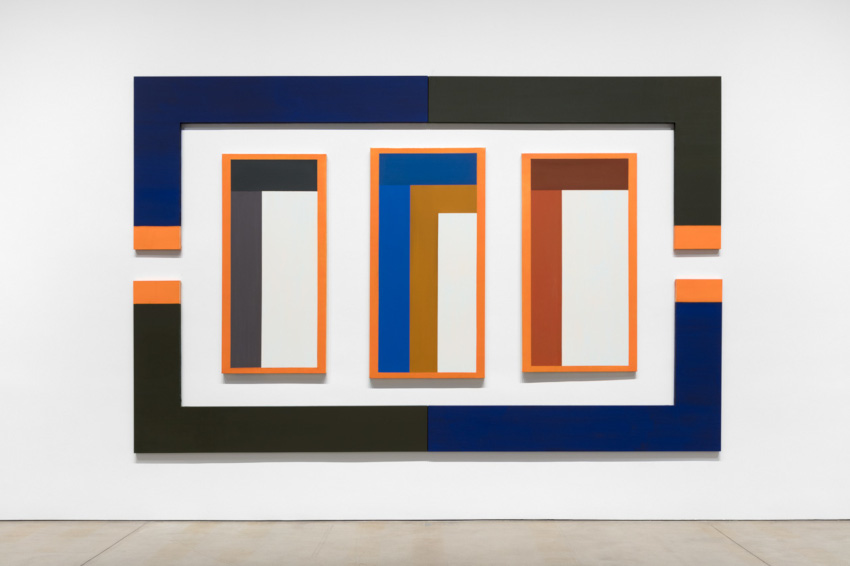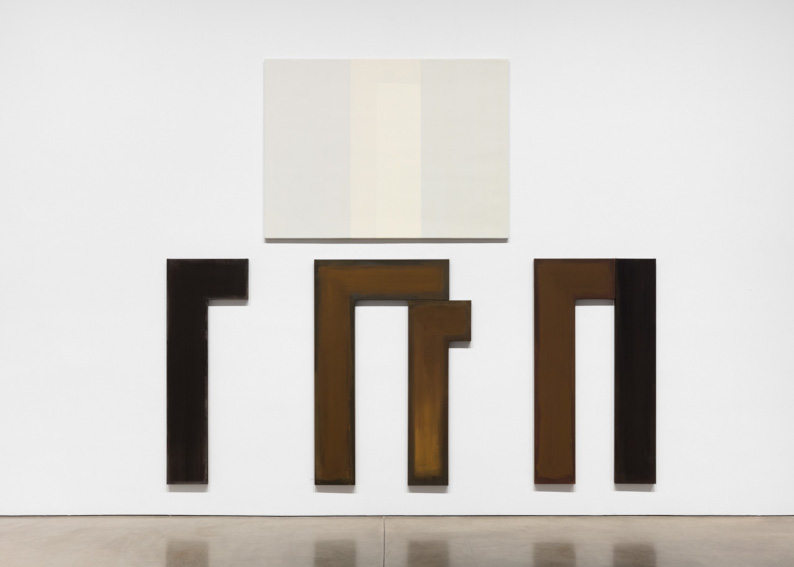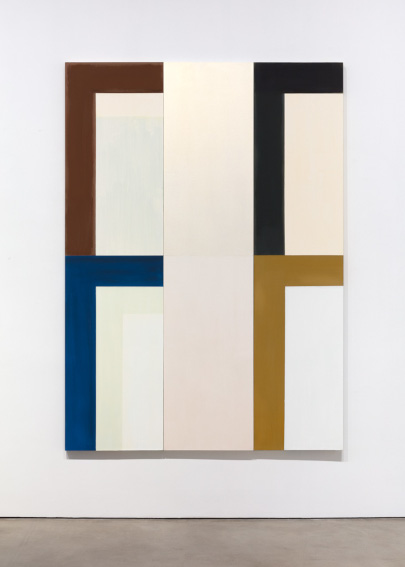
David Novros' Kinesthetic Experiences at Paula Cooper
A week after the closing of David Novros: Paintings 1966, a sparse exhibition of three historic works at Kayne Griffin Corcoran in Los Angeles, Paula Cooper Gallery in New York opened David Novros, an ambitious, multi-media survey of more than a dozen and a half works spanning several decades. Together, the two exhibitions offer a fascinating glimpse of the oeuvre of this artist. All three of the multi-partite works exhibited in Los Angeles inhabited a single, cavernous, geometrically balanced room. Each occupied its own wall, and demonstrated the cunning propensity Novros has for creating works that become one with the surfaces on which they hang. What would normally be considered empty wall space becomes enveloped into the composition, almost turning the paintings into reliefs, or architectural elements integral to the space. The geometry of the gallery furthermore collaborates with the forms in the works, enlarging the experience by suggesting these are not three separate pieces, but one installation—like the three rooms Novros once created for The Menil Collection, which he intended to be perceived as a single aesthetic phenomenon. On the other hand, his exhibition at Paula Cooper—his third solo show at the gallery since 2009—offers a more analytical perspective on the work. Rather than absorbing themselves into the space, the individual works hold their own as objects of visual and intellectual interest. Not to say that anything is lacking or missing here. It is more like this exhibition is intended to introduce us to a broader sens of the ideas Novros is working with. The works on view are so diverse that even long-time Novros admirers will be surprised at how some of the pieces enlarge the visual language for which the artist has become known.
The Work Belongs to Everyone
Novros came of age as an artist in the 1960s. His aesthetic perspective was informed as much by the leading philosophies of the art field as it was informed by the politics of the age. Novros was drafted into the military in the early days of the Vietnam War. He was willing to fight under the right circumstances, but after becoming aware of the disastrous circumstances unfolding in Vietnam, he profoundly questioned the morality of participating in the conflict. Nonetheless, he served—at one point being assigned the job of painting stars on jeeps. His conscientious attitude towards the war informed his viewpoint on art, as well, especially his belief that art should not be held in private collections where only the privileged could admire it. He was an early advocate of the notion that art should be truly public—meaning it should actually be integrated into the fabric of the architecture of public space.

David Novros - Boathouse, 2016. Oil and murano on canvas, 7 panels. Overall dimensions approximately 11 x 20 feet. © 2019 David Novros / Artists Rights Society (ARS), New York. Courtesy Paula Cooper Gallery, New York. Photo: Steven Probert
One of the most direct ways Novros has achieved his vision of truly public art is through the creation of frescoes, an ancient method involving the mixture of the painting medium with the building materials, literally integrating the painting into the wall. One of the most well-known frescoes Novros created was in the home of Donald Judd, but most of his frescoes inhabit public spaces where viewers can interact with them as part of their everyday lives. In addition to his frescoes, Novros has devoted a lot of his work to exploring the meaning and function of murals, especially as they relate to public and architectural space. Is a mural merely a painting placed on a wall? Or can the mural be considered an extension of the wall—is it contained by the building, or is it a fundamental part of the building? By blending techniques like mosaic, mural painting, and multi-paneled relief-like paintings, Novros has expanded the definition of public art, and drawn attention to the need for contemporary art to converse in meaningful ways with the space in which it exists and with the people who inhabit that space.

David Novros - DB, 2016. Oil on canvas, 6 panels. Overall dimensions approximately 11 feet 9 in. x 16 feet. © 2019 David Novros / Artists Rights Society (ARS), New York. Courtesy Paula Cooper Gallery, New York. Photo: Steven Probert
Evolving Pictures
Something else of importance to Novros is that his work instigates a sort of “kinesthetic experience” for viewers—a sensation that the works change as you move around them. The remarkably subtle ways that Novros achieves this effect makes every chance to see an exhibition of his worthwhile. One way he does it is through the use of a murano paint. This unusual medium creates the impression that the color of a surface changes as the viewing conditions evolve, such as when a viewer moves past it or as light fluctuates. You may have noticed this same effect on the surface of cars, or on road signs. Novros uses murano paints to keep our eyes moving around his works. He also keeps our eyes moving by strategically placing right angles, or by careful positioning his panels to guide our gaze. In his current show at Paula Cooper, there are also several works in which Novros uses materials like metal and glass to challenge our perception. In a copper piece from 1995, dents and ridges in the surface of the metal cause fluctuations in color and light as one moves around the work. In “Doumani Portal” (1982), leaded glass and lacquer create similar perceptual shifts.

David Novros - K, 2017. Oil and murano on canvas, 3 panels. Overall dimensions approximately 112 1/2 x 80 1/2 x 1 1/2 in. © 2019 David Novros / Artists Rights Society (ARS), New York. Courtesy Paula Cooper Gallery, New York. Photo: Steven Probert
Perhaps the most intellectually kinesthetic piece on view at Paula Cooper, is a small porcelain sculpture titled “Solar House.” The writing accompanying the show describes the work as an architectural model designed to contain a “mural cycle.” But to me, the work goes beyond being a container. Hanging on the walls surrounding the model are several works on paper that employ the same visual language as the model. The overall effect of the installation suggests that Novros envisions “Solar House” as something timeless, like an updated icon of an ancient cave, the walls of which support archetypal abstract drawings. Here, Novros has combined the cave and the cave art, making them one, drawing our attention to how the spaces in which we dwell have always been as important to our visual culture as the art with which we fill them. David Novros is on view at Paula Cooper Gallery through 15 June 2019.
Featured image: David Novros- Untitled, 1971. Oil on canvas, 5 panels. Overall dimensions 120 1/2 x 156 x 1 1/2 in. © 2019 David Novros / Artists Rights Society (ARS), New York. Courtesy Paula Cooper Gallery, New York. Photo: Steven Probert
All images used for illustrative purposes only
By Phillip Barcio






